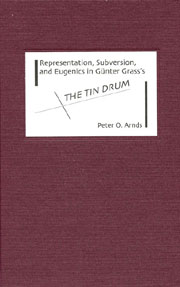Book contents
- Frontmatter
- Contents
- Acknowledgments
- Abbreviations
- Introduction
- 1 Representing Euthanasia; Reclaiming Popular Culture
- 2 Heteroglossia from Grimmelshausen to the Grimm Brothers
- 3 The Dwarf and Nazi Body Politics
- 4 Oskar's Dysfunctional Family and Gender Politics
- 5 Oskar as Fool, Harlequin, and Trickster, and the Politics of Sanity
- 6 Gypsies, the Picaresque Novel, and the Politics of Social Integration
- Epilogue: Beyond Die Blechtrommel: Germans as Victims in Im Krebsgang
- Works Cited
- Index
4 - Oskar's Dysfunctional Family and Gender Politics
Published online by Cambridge University Press: 05 February 2013
- Frontmatter
- Contents
- Acknowledgments
- Abbreviations
- Introduction
- 1 Representing Euthanasia; Reclaiming Popular Culture
- 2 Heteroglossia from Grimmelshausen to the Grimm Brothers
- 3 The Dwarf and Nazi Body Politics
- 4 Oskar's Dysfunctional Family and Gender Politics
- 5 Oskar as Fool, Harlequin, and Trickster, and the Politics of Sanity
- 6 Gypsies, the Picaresque Novel, and the Politics of Social Integration
- Epilogue: Beyond Die Blechtrommel: Germans as Victims in Im Krebsgang
- Works Cited
- Index
Summary
In the Third Reich the persecution of the physically disabled and other groups of so-called asocial life was linked to the perception of them as nutzlose Esser (useless mouths to feed). The parents' abandonment of their children, the question of food (especially in the war years) and the grotesque body connect the historical level of Grass's novel with the fairy-tale world. Grass's portrayal of his dysfunctional family, the Matzeraths, parodies the patriarchal gender patterns of the fairy tales discussed in this study. Die Blechtrommel shares with the Tom Thumb tales and Hauff's dwarf tales such motifs as the complicated relationship the dwarf has with his parents, particularly with his mother, the motif of parental neglect, the sense of shame felt by his parents, and the dwarf's desire to hide from persecution. In the majority of those tales that Aarne and Thompson have identified as the type “The Children and the Ogre,” to which the Grimm Tom Thumb tales and Hänsel und Gretel belong, the abandoned children are reunited with the father at the end, while the mother or stepmother epitomizes a menacing cruelty that needs to be obliterated. This patriarchal order in the tales no longer functions in Die Blechtrommel, where Oskar is clearly responsible for the death of his two putative fathers, and where his relationship with his mother is intensely oedipal. Yet, as we shall see, Oskar's behavior towards his mother also contains much duplicity, marked both by cruelty as well as desire to return to her womb.
- Type
- Chapter
- Information
- Publisher: Boydell & BrewerPrint publication year: 2004

